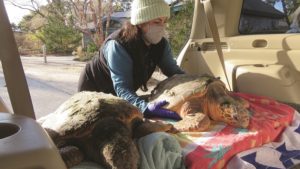WELLFLEET — By now, sea turtles, like hundreds of Outer Cape residents, have headed south to dodge the frost. Where these two seasonal populations diverge: reptiles actually paddle out of Cape Cod Bay, exiting into the ocean and proceeding past the Big Apple, bound for the tropics. A successful journey hinges on whether a turtle can navigate the bay, but the Cape’s hooked tip can whip up some bamboozling currents, and some turtles, many of them juveniles, get trapped.
The turtles’ summertime activities — leisurely snacking on crabs, jellyfish, and algae — wane as temperatures dip lower. If they are still here when the waters hit 50 degrees F, the cold-blooded creatures are in trouble. Unable to swim or eat, cold-stunned turtles are sloshed around the bay, subject to the winds and currents. Over the years, hundreds of sea turtles have washed up on beaches — hypothermic, often afflicted with pneumonia, and sometimes injured.

At each high tide almost every day since Nov. 17, Mass Audubon’s Wellfleet Bay Wildlife Sanctuary has been dispatching volunteers to patrol bayside beaches between Brewster and Truro for turtles. So far this season, according to a sanctuary press release, at least 420 sea turtles have been rescued and recovered: 12 loggerheads, 17 greens, and 391 Kemp’s ridleys.
Loggerhead and green sea turtles are threatened, according to state and federal listings, while the Kemp’s ridley is an endangered species.
Cold-stunned sea turtles need immediate medical attention, which can be provided at the New England Aquarium’s sea turtle hospital and National Marine Life Center in Buzzards Bay. Under both state and federal law, only those with a rescue and recovery permit from the U.S. Fish and Wildlife Service may transport these species. But anyone who comes across a stranded turtle can still offer it a shot at survival.
“The most important thing is to never return it to the water,” said Jenette Kerr, the Wellfleet sanctuary’s communications coordinator, in an email offering steps passersby can take if they encounter a cold-stunned turtle.
Gingerly move the turtle up the beach, well above the high tide line. Tuck it into a blanket of dry seaweed or wrack, which can help ward off the cold — and shield the turtle from the view of hungry gulls. Mark the position with an obvious piece of debris (driftwood, branches, or a buoy work nicely) — or, with your heel, draw a large arrow in the sand. Have the Audubon sanctuary’s 24-hour sea turtle hotline saved in your cell: 508-349-2615, ext. 6104. In due time, they will send an authorized transporter to the rescue.

The recent wave of strandings has prompted calls for banana box donations. The sanctuary is picky about these. Empty Amazon packages won’t work. Nor will those boxes used for stacks of A4 copy paper do.
“Banana boxes are uniquely suited for transporting sea turtles,” said Kerr. “They’re sturdy — each carries bunches of bananas, after all.”
They come with an added bonus: their covers are equipped with a little window, permitting Audubon staff a peek at the turtle without the need to fiddle with flaps or a lid, which may further distress the animal.
Volunteers have gathered banana boxes from grocery stores, but the sanctuary still needs more. For those interested in locating more boxes, Kerr recommends reaching out to smaller grocery stores (Stop & Shop has already been contributing). Rescuers also need donations of bath towels (not hand towels), which offer turtles a bit of comfort when they’re being ferried up Route 6.



